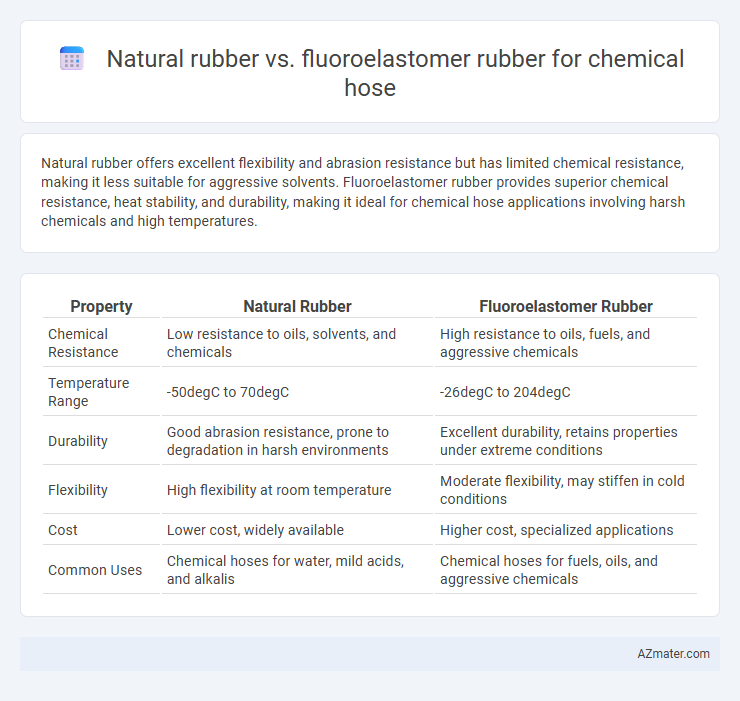Natural rubber offers excellent flexibility and abrasion resistance but has limited chemical resistance, making it less suitable for aggressive solvents. Fluoroelastomer rubber provides superior chemical resistance, heat stability, and durability, making it ideal for chemical hose applications involving harsh chemicals and high temperatures.
Table of Comparison
| Property | Natural Rubber | Fluoroelastomer Rubber |
|---|---|---|
| Chemical Resistance | Low resistance to oils, solvents, and chemicals | High resistance to oils, fuels, and aggressive chemicals |
| Temperature Range | -50degC to 70degC | -26degC to 204degC |
| Durability | Good abrasion resistance, prone to degradation in harsh environments | Excellent durability, retains properties under extreme conditions |
| Flexibility | High flexibility at room temperature | Moderate flexibility, may stiffen in cold conditions |
| Cost | Lower cost, widely available | Higher cost, specialized applications |
| Common Uses | Chemical hoses for water, mild acids, and alkalis | Chemical hoses for fuels, oils, and aggressive chemicals |
Overview of Natural Rubber and Fluoroelastomer Rubber
Natural rubber offers excellent tensile strength, flexibility, and abrasion resistance, making it suitable for moderate chemical handling applications in chemical hoses. Fluoroelastomer rubber provides superior chemical resistance, high temperature tolerance up to 200degC, and resistance to oils, solvents, and aggressive chemicals, ensuring durability in harsh industrial environments. The choice between natural rubber and fluoroelastomer depends on chemical compatibility, operating temperature, and required durability for safe and efficient hose performance.
Chemical Compatibility and Resistance
Natural rubber exhibits excellent flexibility and abrasion resistance but has limited chemical compatibility, particularly poor resistance to oils, fuels, solvents, and many acids, making it unsuitable for harsh chemical hose applications. Fluoroelastomer rubber offers superior chemical resistance, withstanding exposure to hydrocarbons, acids, alkalis, and various aggressive chemicals at elevated temperatures without significant degradation. This makes fluoroelastomer the preferred choice for chemical hoses requiring broad-spectrum chemical compatibility and long service life in corrosive environments.
Mechanical Properties Comparison
Natural rubber exhibits excellent tensile strength and abrasion resistance, making it suitable for flexible and durable chemical hoses with moderate chemical exposure. Fluoroelastomer rubber offers superior heat resistance up to 200-250degC and outstanding chemical resistance against fuels, oils, and aggressive solvents, but typically has lower tensile strength and flexibility compared to natural rubber. Mechanical properties such as elongation at break and compression set behavior favor natural rubber for dynamic flexing, while fluoroelastomers excel in maintaining integrity under harsh chemical and thermal conditions.
Temperature Performance
Natural rubber exhibits excellent flexibility and abrasion resistance but generally operates effectively within a temperature range of -40degC to 80degC, making it less suitable for high-temperature chemical hose applications. Fluoroelastomer rubber, such as Viton, withstands much higher temperatures, typically from -26degC up to 205degC, offering superior chemical resistance and maintaining integrity under extreme heat. This temperature performance makes fluoroelastomer the preferred choice for chemical hoses exposed to hot fluids or harsh environments.
Flexibility and Durability
Natural rubber offers superior flexibility with excellent resilience to repeated bending, making it ideal for applications requiring frequent hose movement. Fluoroelastomer rubber provides outstanding chemical resistance and durability, maintaining structural integrity under harsh chemical exposures and high temperatures. Combining these materials' properties, fluoroelastomer excels in environments demanding long-lasting corrosion resistance, while natural rubber is preferred for flexible, abrasion-resistant chemical hoses.
Cost Analysis
Natural rubber chemical hoses typically offer a lower initial cost, making them budget-friendly for applications with limited chemical exposure or short-term use. Fluoroelastomer rubber hoses, though more expensive upfront due to advanced polymer blends and superior resistance to harsh chemicals and high temperatures, provide greater durability and reduced maintenance costs over time. Evaluating lifecycle expenses reveals fluoroelastomer hoses often deliver better value in corrosive environments despite the higher initial investment.
Typical Industrial Applications
Natural rubber excels in chemical hoses used for handling mild acidic and alkaline substances, commonly applied in water treatment, agriculture, and food processing industries. Fluoroelastomer rubber offers superior resistance to harsh chemicals, oils, fuels, and solvents, making it ideal for aerospace, petrochemical, and pharmaceutical applications requiring high-performance sealing and flexibility. Both materials cater to distinct industrial needs, with natural rubber favored for cost-effective, moderate chemical exposure and fluoroelastomer preferred for aggressive chemical environments.
Environmental Impact and Sustainability
Natural rubber offers better biodegradability and lower environmental footprint due to its renewable, plant-based sourcing, making it a more sustainable choice for chemical hoses. Fluoroelastomer rubber, while highly resistant to chemicals and extreme conditions, is derived from synthetic fluoropolymers that resist degradation and contribute to long-term environmental persistence. Selecting natural rubber helps minimize pollution and supports circular economy principles, whereas fluoroelastomers pose greater challenges for sustainable disposal and recycling efforts.
Maintenance and Service Life
Natural rubber chemical hoses exhibit excellent elasticity and abrasion resistance but degrade faster when exposed to oils, solvents, and aggressive chemicals, leading to more frequent maintenance and shorter service life. Fluoroelastomer rubber hoses provide superior chemical resistance and thermal stability, reducing wear and corrosion while extending service intervals and overall hose longevity in harsh environments. Maintenance costs are lower with fluoroelastomer due to its enhanced durability against acids, fuels, and oxidative agents commonly encountered in chemical processing.
Selection Criteria for Chemical Hoses
Natural rubber offers excellent flexibility and abrasion resistance but has limited chemical resistance, making it suitable for hoses conveying water, oils, and non-aggressive chemicals. Fluoroelastomer rubber provides superior resistance to a wide range of chemicals, including hydrocarbons, acids, and solvents, making it ideal for aggressive chemical transfer applications. Selecting the right chemical hose depends on factors such as chemical compatibility, temperature range, pressure requirements, and environmental conditions to ensure safety and durability.

Infographic: Natural rubber vs Fluoroelastomer rubber for Chemical hose
 azmater.com
azmater.com